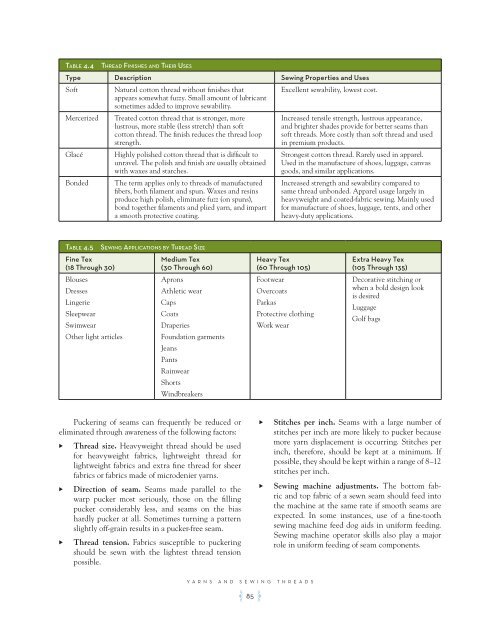You also want an ePaper? Increase the reach of your titles
YUMPU automatically turns print PDFs into web optimized ePapers that Google loves.
Table 4.4 Thread Finishes and Their uses<br />
Type Description Sewing Properties and Uses<br />
Soft Natural cotton thread without finishes that<br />
appears somewhat fuzzy. Small amount of lubricant<br />
sometimes added to improve sewability.<br />
Mercerized Treated cotton thread that is stronger, more<br />
lustrous, more stable (less stretch) than soft<br />
cotton thread. The finish reduces the thread loop<br />
strength.<br />
Glacé Highly polished cotton thread that is difficult to<br />
unravel. The polish and finish are usually obtained<br />
with waxes and starches.<br />
Bonded The term applies only to threads of manufactured<br />
fibers, both filament and spun. Waxes and resins<br />
produce high polish, eliminate fuzz (on spuns),<br />
bond together filaments and plied yarn, and impart<br />
a smooth protective coating.<br />
Table 4.5 sewing appliCaTions bY Thread size<br />
Fine Tex<br />
(18 Through 30)<br />
Blouses<br />
Dresses<br />
Lingerie<br />
Sleepwear<br />
Swimwear<br />
Other light articles<br />
Medium Tex<br />
(30 Through 60)<br />
Aprons<br />
Athletic wear<br />
Caps<br />
Coats<br />
Draperies<br />
Foundation garments<br />
Jeans<br />
Pants<br />
Rainwear<br />
Shorts<br />
Windbreakers<br />
Puckering of seams can frequently be reduced or<br />
eliminated through awareness of the following factors:<br />
u Thread size. Heavyweight thread should be used<br />
for heavyweight fabrics, lightweight thread for<br />
lightweight fabrics and extra fine thread for sheer<br />
fabrics or fabrics made of microdenier yarns.<br />
u Direction of seam. Seams made parallel to the<br />
warp pucker most seriously, those on the filling<br />
pucker considerably less, and seams on the bias<br />
hardly pucker at all. Sometimes turning a pattern<br />
slightly off-grain results in a pucker-free seam.<br />
u Thread tension. <strong>Fabrics</strong> susceptible to puckering<br />
should be sewn with the lightest thread tension<br />
possible.<br />
YARNS AND SEWING THREADS<br />
A 85 F<br />
Excellent sewability, lowest cost.<br />
Increased tensile strength, lustrous appearance,<br />
and brighter shades provide for better seams than<br />
soft threads. More costly than soft thread and used<br />
in premium products.<br />
Strongest cotton thread. Rarely used in apparel.<br />
Used in the manufacture of shoes, luggage, canvas<br />
goods, and similar applications.<br />
Increased strength and sewability compared to<br />
same thread unbonded. Apparel usage largely in<br />
heavyweight and coated-fabric sewing. Mainly used<br />
for manufacture of shoes, luggage, tents, and other<br />
heavy-duty applications.<br />
Heavy Tex<br />
(60 Through 105)<br />
Footwear<br />
Overcoats<br />
Parkas<br />
Protective clothing<br />
Work wear<br />
Extra Heavy Tex<br />
(105 Through 135)<br />
Decorative stitching or<br />
when a bold design look<br />
is desired<br />
Luggage<br />
Golf bags<br />
u Stitches per inch. Seams with a large number of<br />
stitches per inch are more likely to pucker because<br />
more yarn displacement is occurring. Stitches per<br />
inch, therefore, should be kept at a minimum. If<br />
possible, they should be kept within a range of 8–12<br />
stitches per inch.<br />
u Sewing machine adjustments. The bottom fabric<br />
and top fabric of a sewn seam should feed into<br />
the machine at the same rate if smooth seams are<br />
expected. In some instances, use of a fine-tooth<br />
sewing machine feed dog aids in uniform feeding.<br />
Sewing machine operator skills also play a major<br />
role in uniform feeding of seam components.













